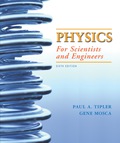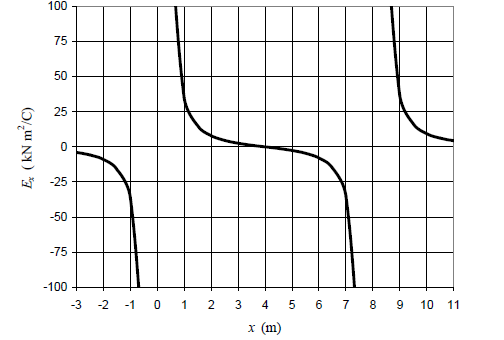
Concept explainers
(a)
The electric field at the distance of
(a)
Explanation of Solution
Given:
The magnitude of the two point charges is
The position of the first point charge is at
The position of the third charge is
Formula used:
Write the expression for the superposition of the electric field.
Here,
Assume
Write the expression for the electric field of the first charge.
Here,
Write the expression for the electric field of the second charge.
Here,
Substitute
The magnitude of
Substitute
Substitute
Conclusion:
The electric field at the distance of
(b)
The electric field at the distance of
(b)
Explanation of Solution
Given:
The magnitude of the two point charges is
The position of the first point charge is at
The position of the third charge is
Formula used:
Write the expression for the superposition of the electric field.
Here,
Assume
Write the expression for the electric field of the first charge.
Here,
Write the expression for the electric field of the second charge.
Here,
Substitute
The magnitude of
Substitute
Calculation:
Substitute
Conclusion:
The electric field at the distance of
(c)
The electric field at the distance of
(c)
Explanation of Solution
Given:
The magnitude of the two point charges is
The position of the first point charge is at
The position of the third charge is
Formula used:
Write the expression for the superposition of the electric field.
Here,
Assume
Write the expression for the electric field of the first charge.
Here,
Write the expression for the electric field of the second charge.
Here,
Substitute
The magnitude of
Substitute
Calculation:
Substitute
Conclusion:
The electric field at the distance of
(d)
The electric field at the distance of
(d)
Explanation of Solution
Given:
The magnitude of the two point charges is
The position of the first point charge is at
The position of the third charge is
Formula used:
Write the expression for the superposition of the electric field.
Here,
Assume
Write the expression for the electric field of the first charge.
Here,
Write the expression for the electric field of the second charge.
Here,
Substitute
The magnitude of
Substitute
Calculation:
Substitute
Conclusion:
The electric field at the distance of
(e)
The position on the x axis where the electric field is zero.
(e)
Explanation of Solution
Given:
Electric field is zero.
Introduction:
Electric field is the region near the charge where the other object will experience a force. The direction of the electric field is in the direction of force. It is basically defined as the electric force per unit charge.
The electric field is zero at the symmetry on the x axis and that is at
Conclusion:
The electric field is zero at the
(f)
The sketch of electric field versus distance.
(f)
Explanation of Solution
Introduction:
Electric field is the region near the charge where the other object will experience a force. The direction of the electric field is in the direction of force. It is basically defined as the electric force per unit charge.
The sketch of the electric field lines and the distance is:

Conclusion:
Thus, the sketch ofelectric field lines and the distance is the curved lines.
Want to see more full solutions like this?
Chapter 21 Solutions
EBK PHYSICS FOR SCIENTISTS AND ENGINEER
- A circular ring of charge of radius b has a total charge q uniformly distributed around it. Find the magnitude of the electric field in the center of the ring. (a) 0 (b) keq/b2 (c) keq2/b2 (d) keq2/b (e) None of these answers is correct.arrow_forwardA point charge of 4.00 nC is located at (0, 1.00) m. What is the x component of the electric field due to the point charge at (4.00, 2.00) m? (a) 1.15 N/C (b) 0.864 N/C (c) 1.44 N/C (d) 1.15 N/C (e) 0.864 N/Carrow_forwardAn electron with a speed of 3.00 106 m/s moves into a uniform electric field of magnitude 1.00 103 N/C. The field lines are parallel to the electrons velocity and pointing in the same direction as the velocity. How far does the electron travel before it is brought to rest? (a) 2.56 cm (b) 5.12 cm (c) 11.2 cm (d) 3.34 m (e) 4.24 marrow_forward
- Consider the electric dipole shown in Figure P19.20. Show that the electric field at a distant point on the + x axis is Ex 4 keqa/x3.arrow_forwardA 1.75-nC charged particle located at the origin is separated by a distance of 0.0825 m from a 2.88-nC charged particle located farther along the positive x axis. If the 1.75-nC particle is kept fixed at the origin, where along the positive x axis should the 2.88-nC particle be located so that the magnitude of the electrostatic force it experiences is twice as great as it was in Problem 27?arrow_forwardA circular ring of charge with radius b has total charge q uniformly distributed around it. What is the magnitude of the electric field at the center of the ring? (a) 0 (b) keq/b2 (c) keq2/b2 (d) keq2/b (e) none of those answersarrow_forward
- Is it possible for a conducting sphere of radius 0.10 m to hold a charge of 4.0 C in air? The minimum field required to break down air and turn it into a conductor is 3.0 106 N/C.arrow_forward(a) Find the electric field at the center of the triangular configuration of charges in Figure 18-54., given that qa=+ 2.50 nC, qb=-8.00 nC, and qc=+ 1.50 nC. (b) Is there any combination of charges, other than qa= qb=qc,that will produce a zero strength electric field at the center of the triangular configuration?arrow_forwardA proton is located at the origin, and a second proton is located on the x-axis at x = 6.00 fm (1 fm = 10-15 m). (a) Calculate the electric potential energy associated with this configuration. (b) An alpha particle (charge = 2e, mass = 6.64 1027 kg) is now placed at (x, y) = (3.00, 3.00) fm. Calculate the electric potential energy associated with this configuration. (c) Starting with the three-particle system, find the change in electric potential energy if the alpha particle is allowed to escape to infinity while the two protons remain fixed in place. (Throughout, neglect any radiation effects.) (d) Use conservation of energy to calculate the speed of the alpha particle at infinity. (e) If the two protons are released from rest and the alpha panicle remains fixed, calculate the speed of the protons at infinity.arrow_forward
- aA plastic rod of length = 24.0 cm is uniformly charged with a total charge of +12.0 C. The rod is formed into a semicircle with its center at the origin of the xy plane (Fig. P24.34). What are the magnitude and direction of the electric field at the origin? Figure P24.34arrow_forwardA uniformly charged insulating rod of length 14.0 cm is bent into the shape of a semicircle as shown in Figure P 19.21. The rod has a total charge of 7.50 C. Find (a) the magnitude and (b) the direction of the electric field at O, the center of the semicircle.arrow_forward
 Principles of Physics: A Calculus-Based TextPhysicsISBN:9781133104261Author:Raymond A. Serway, John W. JewettPublisher:Cengage Learning
Principles of Physics: A Calculus-Based TextPhysicsISBN:9781133104261Author:Raymond A. Serway, John W. JewettPublisher:Cengage Learning Physics for Scientists and Engineers, Technology ...PhysicsISBN:9781305116399Author:Raymond A. Serway, John W. JewettPublisher:Cengage Learning
Physics for Scientists and Engineers, Technology ...PhysicsISBN:9781305116399Author:Raymond A. Serway, John W. JewettPublisher:Cengage Learning Physics for Scientists and Engineers: Foundations...PhysicsISBN:9781133939146Author:Katz, Debora M.Publisher:Cengage Learning
Physics for Scientists and Engineers: Foundations...PhysicsISBN:9781133939146Author:Katz, Debora M.Publisher:Cengage Learning College PhysicsPhysicsISBN:9781938168000Author:Paul Peter Urone, Roger HinrichsPublisher:OpenStax College
College PhysicsPhysicsISBN:9781938168000Author:Paul Peter Urone, Roger HinrichsPublisher:OpenStax College College PhysicsPhysicsISBN:9781305952300Author:Raymond A. Serway, Chris VuillePublisher:Cengage Learning
College PhysicsPhysicsISBN:9781305952300Author:Raymond A. Serway, Chris VuillePublisher:Cengage Learning College PhysicsPhysicsISBN:9781285737027Author:Raymond A. Serway, Chris VuillePublisher:Cengage Learning
College PhysicsPhysicsISBN:9781285737027Author:Raymond A. Serway, Chris VuillePublisher:Cengage Learning





